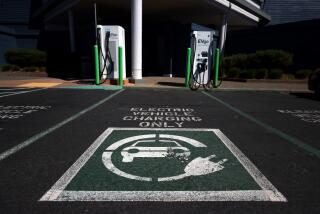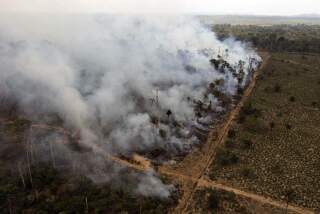Warning is sounded on ethanol use
Ethanol, widely touted as a greenhouse-gas-cutting fuel, would have serious health effects if heavily used in cars, producing more ground-level ozone than gasoline, particularly in the Los Angeles Basin, according to a Stanford University study out today.
“Ethanol is being promoted as a clean and renewable fuel that will reduce global warming and air pollution,” said Mark Z. Jacobson, an associate professor of civil and environmental engineering and author of the study in the online edition of Environmental Science and Technology. “But our results show that a high blend of ethanol poses an equal or greater risk to public health than gasoline, which already causes significant health damage.”
Ozone is a key ingredient in smog, and when inhaled even at low levels it can harm lungs, aggravate asthma and impair immune systems.
The health effects from ethanol use are the same whether it is made from corn or other plant products, Jacobson found.
The study determined that a 9% increase in ozone-related deaths would occur in Greater Los Angeles, and a 4% increase nationally, by 2020 if a form of ethanol called E85, were used instead of gasoline. In the Southeast, by contrast, mortality rates would decrease slightly.
The type of fuel used in the study -- 85% ethanol, 15% gasoline -- emits less greenhouse gases than other types, some researchers say.
“Today, there is a lot of investment in ethanol,” Jacobson said. “The question is, if we’re not getting any health benefits, then why continue to promote ethanol?”
He used a computer model to simulate air quality in 2020 -- when ethanol-fueled vehicles are expected to be widely available in the United States -- with a focus on Los Angeles. His study is the first to combine emissions data with multiple other variables, including climate, population density and current amounts of air pollution, he said.
“The chemicals that come out of a tailpipe are affected by a variety of factors, including chemical reactions, temperatures, sunlight, clouds, wind and precipitation,” he said.
“Overall, health effects depend on exposure to these airborne chemicals, which varies from region to region.... Since Los Angeles has historically been the most polluted airshed in the U.S., the test bed for nearly all U.S. air pollution regulation and home to about 6% of the U.S. population, it is also ideal for a more detailed study,” Jacobson wrote.
President Bush has made increased use of ethanol and other alternative fuels a centerpiece of his strategy to increase reliance on domestic fuels while reducing greenhouse gas emissions.
In his State of the Union address in January, Bush called for annual national production of 35 billion gallons of ethanol by 2017, up from 5 billion gallons in 2006 and nearly five times the target set by Congress. The president’s deputy press secretary requested a copy of Jacobson’s study Tuesday but had no immediate comment.
Kristen Hellmer, a spokeswoman for the White House Council on Environmental Quality, said she had not had a chance to review the study, but reiterated the administration’s support for ethanol.
“I think there are pollutants that contribute to ozone which may slightly increase as a result of more ethanol use, which can be managed by tools which we have available under the Clean Air Act,” Hellmer said.
Jennifer Wood of the U.S. Environmental Protection Agency echoed those remarks in an e-mail.
“While EPA has not fully reviewed the study, the agency’s experience and analysis in developing renewable-fuel standards contradicts the underlying assumptions of the study,” she wrote. “The increased use of renewable fuels, like E85, will significantly reduce greenhouse gas, benzene and carbon monoxide emissions while strengthening our nation’s energy security and supporting American farming communities.
“The pollutants that contribute to ozone, which may slightly increase as a result of additional ethanol use, can be managed by the suite of effective tools available under the Clean Air Act.”
California Air Resources Board spokeswoman Gennet Paauwe said staff researchers are designing their own study to examine potential effects of ethanol on air pollution and health.
Jacobson said there are already an estimated 5,000 premature U.S. deaths annually tied to ozone exposure, in spite of Clean Air Act regulations. He said that he had assumed large reductions in emissions by 2020 because of more stringent air regulations, but that even then, there were significant health risks.
Brooke Coleman, director of the Renewable Energy Action Project in San Francisco, said Jacobson was a respected air quality expert but criticized him for saying there would be increased deaths from E85 and smog.
“He is ignoring the fact that E85 greatly reduces emissions that are much more harmful to humans than smog, such as toxics and soot” particulates, Coleman said in an e-mail.
Jacobson replied that “there is no evidence available to indicate that particulate matter will decrease with the use of E85.... The effect of E85 on increasing mortality is firmly grounded in science based on information available today, and not misleading. What is misleading is the claims made to date that ethanol will improve air quality and health.”
Thirty states, so far, have public E85 fueling stations. Most are in the Midwest. California has one, in San Diego.
*






